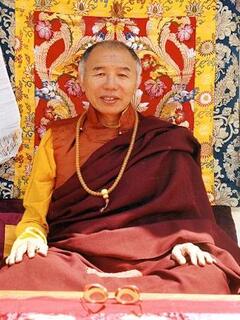In Praise of Kyimolung
In Praise of the Hidden Valley of Kyimolung
by Tulku Urgyen Rinpoche
Ahoye! Completely pure essence, Great Akaniṣṭha in actuality —
From the compassionate display of the unimpeded nature
Gangri Pungyen[1] appears, Heap of Jewel-like Snow Mountains,
Summit above all others, joy of the deities and the Three Roots.
If you look closely, you will notice the detail —
To the east is the emanated realm of deities;[2]
To the south is the Gomasālagandha Stūpa;[3]
To the west is the Vajra Throne,[4] summit of the Noble Land of India;
And to the north are the snowy mountains of the Himalayas.[5]
The mountain ridges connect to Mount Tisé,[6]
Symbolizing the meeting of the lineage of Vajradharas.
The heavens have the blue radiance of lapis lazuli,
Symbolizing the unchanging wisdom of the dharmadhātu.[7]
The seven gleaming, whinnying horses[8] on the face of Mount Kailāsa
Symbolize the all-illuminating mirror-like wisdom.
The medicinal valley, dazzling with all kinds of blossoms,
Symbolizes the effortlessly arising all-accomplishing wisdom.
The brilliant bow of Indra[9] spanning every direction
Symbolizes the boundless wisdom of equality.
The galleried cliffs with their overhanging aviaries
Symbolize the unsought discriminating wisdom.
The absolute and terrestrial are indivisible here.
Great bodhisattvas of the past, abiding on the bhūmis,
Traversed these lands, leaving their legacy —
Blessed decrees and mudrās, inexpressible, beyond words.
Ever since then, unequivocally, the Three Protectors,[10] with Padmasambhava,
Have blessed these lands with their threefold secret of body, speech, and mind.
In the caves where the king and princes trained in liberation,
Perfected their skill in realization, and basked in experience —
Those sublime beings of generation and completion,
Like moving dancers, come to mind again and again.
Then, due to karma and connected aspirations,
Chokgyur Lingpa arrived in these times as Guru Rinpoche’s regent.
In this sacred land of symbols, meanings, and signs,[11]
Fortunate men and women of times to come
Will take to places of one-pointed practice,
Entering into the path of ripening and liberation.
For all these practitioners, samaya holders,
The power of realization will be thus perfected—the flourishing of awakened wisdom.
When at last this samsaric body is cast aside,
Within the expanse of the ever-excellent dharmakāya, emaho!
Upon the request of the king's heirs,[12]
I, Urgyen, could not help but respond with chatter,
Like the striking of a sandalwood mallet on a goatskin drum,
And offered these words just as they came to mind.
Maṅgalam!
Written by Karma Urgyen.
| Samye Translations, 2018. (Translated by Kaleb Yaniger and Stefan Mang. Edited by Libby Hogg and Adam Pearcey.)
Version: 1.3-20240815
-
Gangri Pungyen (gangs ri spungs rgyan) translates as ‘Ornamented Heap Mountain’ and refers to Mount Manaslu. Mount Manaslu is the eighth highest mountain in the world at 8,163 meters above sea level. Gangri Pungyen towers over the entire Nubri valley and is recognized as a sacred mountain, and home to the local protector deity. ↩
-
Lhasa’s Jokhang. ↩
-
The Svayambhū stūpa. ↩
-
Bodh Gaya, India. ↩
-
Mount Everest. ↩
-
Mount Kailash. ↩
-
Tulku Urgyen Rinpoche equates the sacred landscape of Nubri with the five wisdoms (ye shes lnga), beginning with the wisdom of the dharmadhātu (chos dbyings ye shes). ↩
-
An epithet of the sun used in poetry. In ancient India the sun was often described as being drawn by seven horses. ↩
-
A poetic epithet used for rainbows. ↩
-
The Three Protectors (mgon po gsum) are Mañjuśrī, Avalokiteśvara and Vajrapāṇi. ↩
-
Symbol, meaning, and sign (brda don rtags gsum) refer to three aspects of the vajrayāna teachings. For example, the peaceful and wrathful deities as depicted are the symbol. The meaning that they symbolize is the enlightened qualities spontaneously present within buddhanature. The sign is that they naturally manifest during the bardo of dharmatā. ↩
-
Here Tulku Urgyen Rinpoche respectfully refers to the people of Nubri who requested this text as the 'heirs' of King Tri Songdetsen. ↩
